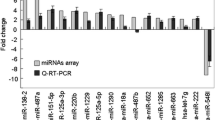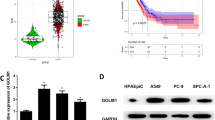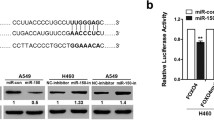Abstract
The major cause of cancer-related deaths in patients with lung adenocarcinoma (LAD) is due to distant metastasis. Many reports have indicated that miRNA plays a key role in tumour metastasis. The expression of miR-197 is correlated with LAD progression, however, the mechanism of miR-197 is still unknown in the processing of LAD. A Boyden chamber migration/invasion assay was used for the metastatic function study in vitro. Real-time PCR and Western blot assays were employed to analyse the EMT hallmark changes in both the mRNA and protein levels. \(3^{\prime }\)-UTR reporter luciferase assay was used to show that HIPK2 is a direct target of miR-197. miR-197 enhances LAD cell migration and invasion miR-197. The downregulation of miR-197 suppresses the EMT and migration ability. HIPK2 is a direct functional target of miR-197 in LAD metastasis. In summary, miR-197 controls EMT and metastasis by directly silencing HIPK2. The findings suggest that interfering with the miR-197-dependent regulation of HIPK2 could be a useful approach for the treatment of patients with late stage metastatic LAD.





Similar content being viewed by others
References
Brabletz T. 2012 EMT and MET in metastasis: where are the cancer stem cells? Cancer Cell. 22, 699–701.
Burk U., Schubert J., Wellner U., Schmalhofer O., Vincan E., Spaderna S. et al. 2008 A reciprocal repression between ZEB1 and members of the miR-200 family promotes EMT and invasion in cancer cells. EMBO Rep. 9, 582–589.
Cekaite L., Eide P. W., Lind G. E., Skotheim R. I. and Lothe R. A. 2016 MicroRNAs as growth regulators, their function and biomarker status in colorectal cancer. Oncotarget 7, 6476–6505.
Chang C. J., Chao C. H., Xia W., Yang J. Y., Xiong Y., Li C. W. et al. 2011 P53 regulates epithelial-mesenchymal transition and stem cell properties through modulating miRNAs. Nat. Cell Biol. 13, 317–323.
Chen W., Fan X. M., Mao L., Zhang J. Y., Li J., Wu J. Z. et al. 2015 MicroRNA-224: as a potential target for miR-based therapy of cancer. Tumour Biol. 36, 6645–6652.
Dai W., Wang C., Wang F., Wang Y., Shen M., Chen K. et al. 2014 Anti-miR-197 inhibits migration in HCC cells by targeting KAI 1/CD82. Biochem. Biophys. Res. Commun. 446, 541–548.
Dey S., Sayers C. M., Verginadis I. I., Lehman S. L., Cheng Y., Cerniglia G. J. et al. 2015 ATF4-dependent induction of heme oxygenase 1 prevents anoikis and promotes metastasis. J. Clin. Invest. 125, 2592–2608.
Du L., Schageman J. J., Subauste M. C., Saber B., Hammond S. M., Prudkin L. et al. 2009 miR-93, miR-98, and miR-197 regulate expression of tumor suppressor gene FUS1. Mol. Cancer Res. 7, 1234–1243.
Hamada S., Satoh K., Miura S., Hirota M., Kanno A., Masamune A. et al. 2013 miR-197 induces epithelial-mesenchymal transition in pancreatic cancer cells by targeting p120 catenin. J. Cell Physiol. 228, 1255–1263.
Iliopoulos D., Lindahl-Allen M., Polytarchou C., Hirsch H. A., Tsichlis P. N. and Struhl K. 2010 Loss of miR-200 inhibition of Suz12 leads to polycomb-mediated repression required for the formation and maintenance of cancer stem cells. Mol. Cell 39, 761–772.
Liang J., Li Y., Daniels G., Sfanos K., De Marzo A., Wei J. et al. 2015 LEF1 targeting EMT in prostate cancer invasion is regulated by miR-34a. Mol. Cancer Res. 13, 681–688.
Listing H., Mardin W. A., Wohlfromm S., Mees S. T. and Haier J. 2015 MiR-23a/-24-induced gene silencing results in mesothelial cell integration of pancreatic cancer. Br. J. Cancer 112, 131–139.
Martello G., Rosato A., Ferrari F., Manfrin A., Cordenonsi M., Dupont S. et al. 2010 A microRNA targeting dicer for metastasis control. Cell 141, 1195–1207.
Mavridis K., Gueugnon F., Petit-Courty A., Courty Y., Barascu A., Guyetant S. et al. 2015 The oncomiR miR-197 is a novel prognostic indicator for non-small cell lung cancer patients. Br. J. Cancer 112, 1527–1535.
Puisieux A., Brabletz T. and Caramel J. 2014 Oncogenic roles of EMT-inducing transcription factors. Nat. Cell Biol. 16, 488–494.
Rabinowits G., Gerçel-Taylor C., Day J. M., Taylor D. D. and Kloecker G. H. 2009 Exosomal microRNA: a diagnostic marker for lung cancer. Clin. Lung Cancer 10, 42–46.
Sequist L. V., Yang J. C., Yamamoto N., O’Byrne K., Hirsh V., Mok T. et al. 2013 Phase III study of afatinib or cisplatin plus pemetrexed in patients with metastatic lung adenocarcinoma with EGFR mutations. J. Clin. Oncol. 31, 3327–3334.
Song S. J., Poliseno L., Song M. S., Ala U., Webster K., Ng C. et al. 2013 MicroRNA-antagonism regulates breast cancer stemness and metastasis via TET-family-dependent chromatin remodeling. Cell 154, 311–324.
Song Y., Li J., Zhu Y., Dai Y., Zeng T., Liu L. et al. 2014 MicroRNA-9 promotes tumor metastasis via repressing E-cadherin in esophageal squamous cell carcinoma. Oncotarget 5, 11669–11680.
Tang J., Li Y., Wang J., Wen Z., Lai M. and Zhang H. 2016 Molecular mechanisms of microRNAs in regulating epithelial-mesenchymal transitions in human cancers. Cancer Lett. 371, 301–313.
Tian L. Q., Liu E. Q., Zhu X. D., Wang X. G., Li J. and Xu G. M. 2016 MicroRNA-197 inhibits cell proliferation by targeting GAB2 in glioblastoma. Mol. Med. Rep. 13, 4279–4288.
Tsai J. H. and Yang J. 2013 Epithelial-mesenchymal plasticity in carcinoma metastasis. Genes Dev. 27, 2192–2206.
Wang H., Su X., Yang M., Chen T., Hou J., Li N. et al. 2015 Reciprocal control of miR-197 and IL-6/STAT3 pathway reveals miR-197 as potential therapeutic target for hepatocellular carcinoma. Oncoimmunology 4, e1031440.
Wu Y., Liu H., Shi X., Yao Y., Yang W. and Song Y. 2015 The long non-coding RNA HNF1A-AS1 regulates proliferation and metastasis in lung adenocarcinoma. Oncotarget 6, 9160–9172.
Xin J., Zhang X. K., Xin D. Y., Li X. F., Sun D. K., Ma Y. Y. et al. 2015 FUS1 acts as a tumor-suppressor gene by upregulating miR-197 in human glioblastoma. Oncol. Rep. 34, 868–876.
Yang Y., Li F., Saha M. N., Abdi J., Qiu L. and Chang H. 2015 miR-137 and miR-197 induce apoptosis and suppress tumorigenicity by targeting MCL-1 in multiple myeloma. Clin. Cancer Res. 21, 2399–2411.
Author information
Authors and Affiliations
Corresponding author
Additional information
Corresponding editor: Dhavendra Kumar
NZ carried out most of the experiments and drafted the manuscript. LT carried out migration and invasion assays. ZM designed the study and performed the statistical analysis. NG conceived the study, and designed and coordinated, and helped to draft the manuscript. All authors read and approved the final manuscript.
Rights and permissions
About this article
Cite this article
Zhang, N., Tian, L., Miao, Z. et al. MicroRNA-197 induces epithelial–mesenchymal transition and invasion through the downregulation of HIPK2 in lung adenocarcinoma. J Genet 97, 47–53 (2018). https://doi.org/10.1007/s12041-018-0881-4
Received:
Revised:
Accepted:
Published:
Issue Date:
DOI: https://doi.org/10.1007/s12041-018-0881-4




